Inverse Converse And Contrapositive

The concepts of inverse, converse, and contrapositive are fundamental in logic and mathematics, particularly in the study of conditional statements. Understanding these concepts is crucial for making logical deductions and arguments. In this article, we will delve into the definitions, examples, and implications of inverse, converse, and contrapositive statements, exploring their roles in various mathematical and logical contexts.
Conditional Statements and Their Variations

A conditional statement is a statement of the form “If p, then q,” where p is the hypothesis and q is the conclusion. This can be denoted as p → q. From this basic form, we can derive three other types of statements: the converse, the inverse, and the contrapositive.
Converse Statement
The converse of a conditional statement p → q is given by q → p. Essentially, it reverses the direction of the original implication. For instance, if we have the statement “If it is raining, then the streets are wet,” the converse would be “If the streets are wet, then it is raining.” Note that the truth of the original statement does not necessarily imply the truth of its converse.
Inverse Statement
The inverse of a conditional statement p → q is given by ~p → ~q, where ~ denotes negation. Thus, the inverse statement negates both the hypothesis and the conclusion of the original statement. Using the previous example, the inverse would be “If it is not raining, then the streets are not wet.” Like the converse, the truth of the inverse is not guaranteed by the truth of the original statement.
Contrapositive Statement
The contrapositive of a conditional statement p → q is given by ~q → ~p. This statement is logically equivalent to the original statement, meaning that it has the same truth value as the original statement in all possible cases. For the example statement, the contrapositive would be “If the streets are not wet, then it is not raining.” The contrapositive is particularly useful in proofs and logical arguments because it provides an alternative way to express a conditional statement that is logically equivalent to the original.
| Statement Type | Form | Example |
|---|---|---|
| Original | p → q | If it is raining, then the streets are wet. |
| Converse | q → p | If the streets are wet, then it is raining. |
| Inverse | ~p → ~q | If it is not raining, then the streets are not wet. |
| Contrapositive | ~q → ~p | If the streets are not wet, then it is not raining. |

Applications and Implications

The concepts of inverse, converse, and contrapositive have significant implications in various fields, including mathematics, computer science, and philosophy. In mathematical proofs, for example, contrapositives are often used to prove conditional statements by proving their contrapositives instead. This can sometimes simplify the proof process by providing a more direct or intuitive path to demonstrating the truth of the original statement.
Logical Arguments and Deductions
In the context of logical arguments, understanding these concepts helps in evaluating the validity of deductions. For instance, if a conclusion is drawn based on the converse or inverse of a given statement without proper justification, it may lead to a logical fallacy. Recognizing the distinction between these variations of conditional statements is essential for constructing sound arguments.
Key Points
- The converse of a statement reverses the hypothesis and conclusion.
- The inverse of a statement negates both the hypothesis and the conclusion.
- The contrapositive of a statement is logically equivalent to the original and negates both the conclusion and the hypothesis in a specific order.
- Understanding these concepts is crucial for valid logical deductions and arguments.
- The contrapositive is particularly useful in mathematical proofs and logical reasoning.
Conclusion and Future Directions
In conclusion, the concepts of inverse, converse, and contrapositive are foundational in logic and have far-reaching implications in various fields. As we continue to advance in mathematics, computer science, and other disciplines that rely heavily on logical reasoning, understanding these concepts will remain essential. Future studies and applications may further illuminate the roles and utilities of these conditional statement variations, potentially leading to new methodologies in proof construction, argumentation theory, and artificial intelligence.
What is the main difference between the converse and the inverse of a conditional statement?
+The converse of a statement p → q is q → p, reversing the direction of the implication, while the inverse is ~p → ~q, negating both the hypothesis and the conclusion.
Why is the contrapositive important in logical reasoning?
+The contrapositive, ~q → ~p, is logically equivalent to the original statement p → q, making it a valuable tool in proofs and logical arguments, as it provides an alternative way to express a statement that is guaranteed to have the same truth value as the original.
Can the converse or inverse of a statement be logically equivalent to the original statement?
+No, the converse and inverse are not logically equivalent to the original statement. Only the contrapositive has this property.



